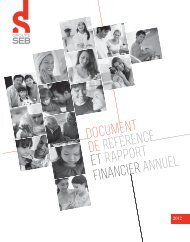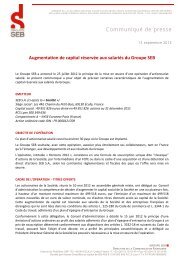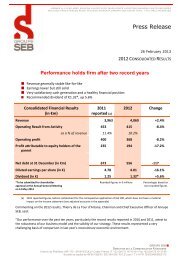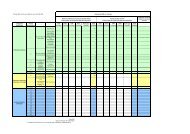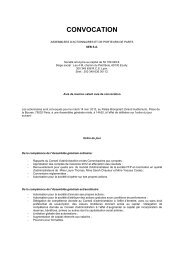Financial Report and Registration Document 2010 - Groupe Seb
Financial Report and Registration Document 2010 - Groupe Seb
Financial Report and Registration Document 2010 - Groupe Seb
You also want an ePaper? Increase the reach of your titles
YUMPU automatically turns print PDFs into web optimized ePapers that Google loves.
3<br />
CONSOLIDATED FINANCIAL STATEMENTS<br />
NOTES TO THE CONSOLIDATED FINANCIAL STATEMENTS<br />
25.3. INFORMATION ON ASSETS AND FINANCIAL LIABILITIES MEASURED AT FAIR VALUE<br />
In accordance with the amended IFRS 7, fair value measurements are<br />
classifi ed using a fair value hierarchy that refl ects the signifi cance of the<br />
inputs used in making the measurements. The hierarchy breaks down into<br />
three levels, as follows:<br />
level 1: quoted prices in active markets for the same instrument;<br />
level 2: quoted prices in active markets for similar assets or liabilities or<br />
other valuation techniques for which all significant inputs are based on<br />
observable market data;<br />
level 3: valuation techniques for which any significant input is not based<br />
on observable market data.<br />
31 December <strong>2010</strong><br />
(in € millions)<br />
Total Level 1 Level 2 Level 3<br />
ASSETS<br />
Derivative instruments 16.5 16.5<br />
Cash <strong>and</strong> cash equivalents 236.6 236.6<br />
TOTAL FINANCIAL ASSETS MEASURED<br />
AT FAIR VALUE 253.1 236.6 16.5 0.0<br />
LIABILITIES<br />
Derivative instruments 6.0 6.0<br />
TOTAL FINANCIAL LIABILITIES MEASURED<br />
AT FAIR VALUE 6.0 0.0 6.0 0.0<br />
The portfolio of derivatives used by the Group to manage risk mainly<br />
includes forward currency contracts, interest rate <strong>and</strong> currency swaps <strong>and</strong><br />
commodities options. These instruments are classified as Level 2, as their fair<br />
value is calculated using internal valuation models based on observable data.<br />
NOTE 26<br />
MARKET RISK MANAGEMENT<br />
3<br />
26.1. RISK MANAGEMENT<br />
Risks are managed by Corporate Finance, based on financial market<br />
conditions <strong>and</strong> in accordance with procedures established by the Group.<br />
Hedging transactions are carried out in the financial markets with a<br />
limited number of high-quality partners in order to avoid counterparty risk.<br />
Subsidiaries’ risks are hedged at corporate level when this is allowed under<br />
the laws <strong>and</strong> regulations of the country concerned <strong>and</strong> when the hedges<br />
can be arranged on the financial markets.<br />
Subsidiaries that are prevented from hedging financial risks through<br />
Corporate Finance due to local laws <strong>and</strong> regulations enter into hedging<br />
transactions directly with local banks in compliance with Group procedures<br />
<strong>and</strong> policies.<br />
26.2. MARKET RISKS<br />
26.2.1. Currency risks<br />
The majority of Group sales are billed in currencies other than the euro,<br />
mainly the US dollar, Russian ruble, Brazilian real <strong>and</strong> Japanese yen.<br />
Most billing currencies correspond to the functional currencies of the<br />
subsidiaries concerned <strong>and</strong> do not give rise to any transactional currency<br />
risk at the local level.<br />
Similarly, goods purchased for resale billed in US dollars are bought from<br />
Asian suppliers by SEB Asia whose functional currency is also the US dollar.<br />
The main sources of transactional currency risks therefore arise from:<br />
intra-group billings between two Group companies with different functional<br />
currencies, as follows:<br />
exports by manufacturing subsidiaries in the euro zone billed in the<br />
local currency of the marketing subsidiaries,<br />
imports of goods from SEB Asia billed in US dollars by marketing<br />
subsidiaries whose functional currency is not the US dollar;<br />
purchases of industrial components from external suppliers by the<br />
manufacturing subsidiaries, that are billed in a currency other than their<br />
functional currency (for example, components purchases by French<br />
subsidiaries that are billed in US dollars).<br />
These risks are managed at Group level by SEB S.A., which acts as the<br />
subsidiaries’ sole counterparty except where this is not possible due to<br />
local regulations. The resulting balance sheet currency positions in the main<br />
currencies are partly hedged by means of forward sales <strong>and</strong> purchases of<br />
foreign currency against the euro. Part of SEB Asia’s US dollar billings to<br />
subsidiaries is hedged. In <strong>2010</strong>, 2009 <strong>and</strong> 2008 the Group was a net buyer<br />
of US dollars.<br />
The Group’s overall currency risk management policy sets very strict rules<br />
for the hedging of currency risks associated with highly probable future<br />
transactions.<br />
GROUPE SEB<br />
FINANCIAL REPORT AND REGISTRATION DOCUMENT <strong>2010</strong><br />
105



